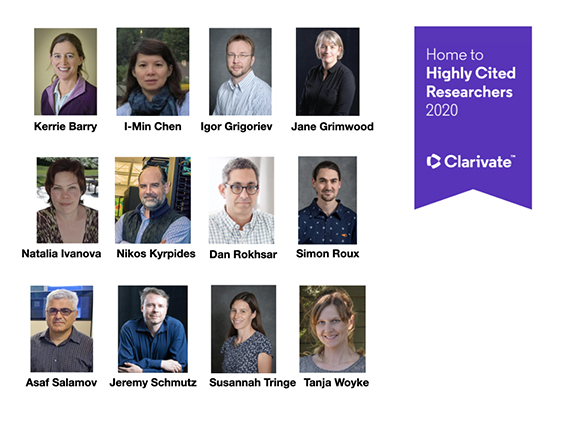 Congratulations to the 2020 Highly Cited Researchers at the JGI! They are among those recognized by Clarivate Analytics as “true pioneers in their fields over the last decade, demonstrated by the production of multiple highly-cited papers that rank in the top 1% by citations for field and year in the Web of Science.”
Congratulations to the 2020 Highly Cited Researchers at the JGI! They are among those recognized by Clarivate Analytics as “true pioneers in their fields over the last decade, demonstrated by the production of multiple highly-cited papers that rank in the top 1% by citations for field and year in the Web of Science.”
Less than 6,200 researchers working in 21 fields appear on the list, and those from the JGI are:
- Kerrie Barry
- I-Min Chen
- Igor Grigoriev
- Jane Grimwood
- Natalia Ivanova
- Nikos Kyrpides
- Dan Rokhsar
- Simon Roux
- Asaf Salamov
- Jeremy Schmutz
- Susannah Tringe
- Tanja Woyke
Below are a few projects each of these researchers were involved in, reported on over the last year:
- Kerrie Barry, Jane Grimwood, and Jeremy Schmutz were part of a consortium that released a very high quality reference genome sequence of green millet (Setaria viridis) in Nature Biotechnology. The work also led researchers to identify a gene related to seed dispersal in wild populations for the first time.
- I-Min Chen, Natalia Ivanova, Nikos Kyrpides, Simon Roux, Susannah Tringe, and Tanja Woyke were part of a “big data” mining effort reported in Nature Biotechnology that led to the release of 52,515 publicly-available microbial draft genomes generated from environmental samples around the world. Much of the data had been generated from samples provided by more than 200 scientists and sequenced by the JGI through the Community Science Program, and already available on the JGI’s Integrated Microbial Genomes & Microbiomes (IMG/M) platform.
- Nikos Kyrpides and Simon Roux are part of a team that developed CheckV, an automated tool to help researchers assess and improve the quality of metagenome-assembled viral genomes. The paper appeared in Nature Biotechnology.
- Igor Grigoriev and Asaf Salamov were part of a JGI-led team that applied machine learning to classify 101 representative genomes of Dothideomycetes, the largest class of fungi, by lifestyles. Additionally, as part of an international consortium, they conducted a large-scale comparison of 135 fungal sequenced genomes to understand how plants and fungi developed symbiotic relationships, and how the mutualistic associations allow host plants to acquire nutrients. The papers appeared in Studies in Mycology and in Nature Communications, respectively.
- Dan Rokhsar and Jeremy Schmutz were part of a team that released a reference genome sequence and genomic toolkit for the perennial grass Miscanthus sinensis in Nature Communications. The reference genome for M. sinensis can both inform and benefit from breeding programs of related candidate bioenergy feedstock crops such as sugarcane and sorghum.